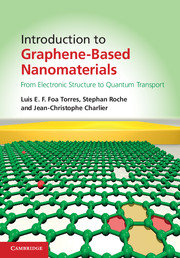Book contents
- Frontmatter
- Contents
- Preface
- 1 Introduction to carbon-based nanostructures
- 2 Electronic properties of carbon-based nanostructures
- 3 Quantum transport: general concepts
- 4 Klein tunneling and ballistic transport in graphene and related materials
- 5 Quantum transport in disordered graphene-based materials
- 6 Quantum transport beyond DC
- 7 Ab initio and multiscale quantum transport in graphene-based materials
- 8 Applications
- Appendix A Electronic structure calculations: the density functional theory (DFT)
- Appendix B Electronic structure calculations: the many-body perturbation theory (MBPT)
- Appendix C Green's functions and ab initio quantum transport in the Landauer–Büttiker formalism
- Appendix D Recursion methods for computing the DOS and wavepacket dynamics
- References
- Index
2 - Electronic properties of carbon-based nanostructures
Published online by Cambridge University Press: 05 February 2014
- Frontmatter
- Contents
- Preface
- 1 Introduction to carbon-based nanostructures
- 2 Electronic properties of carbon-based nanostructures
- 3 Quantum transport: general concepts
- 4 Klein tunneling and ballistic transport in graphene and related materials
- 5 Quantum transport in disordered graphene-based materials
- 6 Quantum transport beyond DC
- 7 Ab initio and multiscale quantum transport in graphene-based materials
- 8 Applications
- Appendix A Electronic structure calculations: the density functional theory (DFT)
- Appendix B Electronic structure calculations: the many-body perturbation theory (MBPT)
- Appendix C Green's functions and ab initio quantum transport in the Landauer–Büttiker formalism
- Appendix D Recursion methods for computing the DOS and wavepacket dynamics
- References
- Index
Summary
Introduction
As described in Chapter 1, the sp2 carbon-based family exhibits a great variety of allotropes, from the low-dimensional fullerenes, nanotubes and graphene ribbons, to two-dimensional monolayer graphene, or stacked graphene multilayers. Two-dimensional monolayer graphene stands as the building block, since all the other forms can be derived from it. Graphene nanoribbons can be seen as quasi-one-dimensional structures, with one lateral dimension short enough to trigger quantum confinement effects. Carbon nanotubes can be geometrically constructed by folding graphene nanoribbons into cylinders, and graphite results from the stacking of a very large number of weakly bonded graphene monolayers.
The isolation of a single graphene monolayer by mechanical exfoliation (repeated peeling or micromechanical cleavage) starting from bulk graphite has been actually quite a surprise, since it was previously believed to be thermodynamically unstable (Novoselov et al., 2004, Novoselov et al., 2005b). At the same time, the route for controlling the growth of graphene multilayers on top of silicon carbide by thermal decomposition was reported, and eventually led to fabrication of single graphene monolayers of varying quality depending on the surface termination (silicon or carbon termination) (Berger et al., 2006). Basic electronic properties of graphene were actually well-known since the seminal work by Wallace in the late forties (Wallace, 1947), such as the electron–hole symmetry of the band structure and the specific linear electronic band dispersion near the Brillouin zone corners (Dirac point), but it was after the discovery of carbon nanotubes by Iijima from NEC (Iijima, 1991) that the exploration of electronic properties of graphene-based materials was revisited (for a review see Charlier, Blase & Roche 2007).
- Type
- Chapter
- Information
- Introduction to Graphene-Based NanomaterialsFrom Electronic Structure to Quantum Transport, pp. 11 - 90Publisher: Cambridge University PressPrint publication year: 2014



